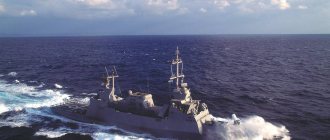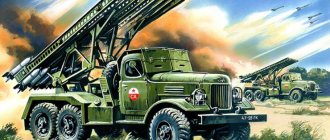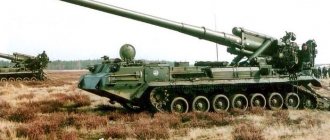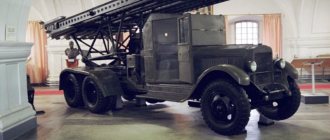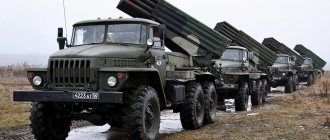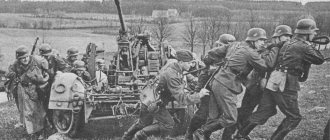Katyusha combat rocket launchers. Reference
The BM-13 received its baptism of fire on July 14, 1941, when the battery fired the first salvo of all installations at the Orsha railway station, where a large amount of enemy manpower and military equipment was concentrated. As a result of a powerful fire strike by 112 rockets simultaneously, a fire glow rose above the station: enemy trains were burning, ammunition was exploding. Another hour and a half later, Flerov’s battery fired a second salvo, this time at the crossing of the Orshitsa River, on the outskirts of which a lot of German equipment and manpower had accumulated. As a result, the enemy's crossing was disrupted and he was unable to develop his success in this direction.
The first experience of using the new missile weapon showed its high combat effectiveness, which was one of the reasons for its rapid commissioning and equipping the Ground Forces with it.
The restructuring of industry associated with the production of missile weapons was carried out in a short time; a large number of enterprises were involved in its production (already in July-August 1941 - 214 factories), which ensured the supply of this military equipment to the troops. In August-September 1941, serial production of BM‑8 combat installations with 82-mm rockets was launched.
Simultaneously with the deployment of production, work continued to create new and improve existing models of missiles and launchers.
On July 30, 1941, a special design bureau (SKB) at the Moscow one began work - the head design bureau for launchers, and the plant itself became the head enterprise for their production. This SKB, under the leadership of the head and chief designer Vladimir Barmin, during the war years developed 78 samples of launchers of various types, mounted on cars, tractors, tanks, railway platforms, river and sea ships. Thirty-six of them were put into service, mastered by industry and used in combat.
Much attention was paid to the production of rockets, the creation of new ones and the improvement of existing models. The 82-mm M-8 rocket was modernized, and powerful high-explosive rockets were created: 132-mm M-20, 300-mm M-30 and M-31; increased range - M-13 DD and improved accuracy - M-13 UK and M-31 UK.
With the beginning of the war, special troops were created within the Armed Forces of the USSR for the combat use of missile weapons. These were rocket troops, but during the war they were called guards mortar units (GMC), and later - rocket artillery. The first organizational form of the MMC was separate batteries and divisions.
By the end of the war, rocket artillery had 40 separate divisions (38 M-13 and 2 M-8), 115 regiments (96 M-13 and 19 M-8), 40 separate brigades (27 M-31 and 13 M-31-12 ) and 7 divisions - a total of 519 divisions in which there were over 3,000 combat vehicles.
The legendary Katyushas took part in all major operations during the war.
The fate of the first separate experimental battery was cut short at the beginning of October 1941. After a baptism of fire near Orsha, the battery successfully operated in battles near Rudnya, Smolensk, Yelnya, Roslavl and Spas-Demensk. Over the course of three months of hostilities, Flerov’s battery not only inflicted considerable material damage on the Germans, it also contributed to raising the morale of our soldiers and officers, exhausted by continuous retreats.
The Nazis staged a real hunt for new weapons. But the battery did not stay long in one place - after firing a salvo, it immediately changed position. The tactical technique - salvo - change of position - was widely used by Katyusha units during the war.
At the beginning of October 1941, as part of a group of troops on the Western Front, the battery found itself in the rear of the Nazi troops. While moving to the front line from the rear on the night of October 7, she was ambushed by the enemy near the village of Bogatyr, Smolensk region. Most of the battery personnel and Ivan Flerov were killed, having shot all the ammunition and blown up the combat vehicles. Only 46 soldiers managed to escape from the encirclement. The legendary battalion commander and the rest of the soldiers, who had fulfilled their duty to the end with honor, were considered “missing in action.” And only when it was possible to discover documents from one of the Wehrmacht army headquarters, which reported what actually happened on the night of October 6-7, 1941 near the Smolensk village of Bogatyr, Captain Flerov was excluded from the lists of missing persons.
For heroism, Ivan Flerov was posthumously awarded the Order of the Patriotic War, 1st degree, in 1963, and in 1995 he was posthumously awarded the title of Hero of the Russian Federation.
In honor of the battery’s feat, a monument was built in the city of Orsha and an obelisk near the city of Rudnya.
Device
Projectile
The weapon is relatively simple, consisting of rail guides and a device for guiding them. For aiming, rotating and lifting mechanisms and an artillery sight were provided. There were two jacks at the rear of the vehicle, providing greater stability when firing. One machine could accommodate from 14 to 48 guides.
The body of the rocket (missile) was a welded cylinder divided into three compartments - the warhead compartment, the engine compartment (combustion chamber with fuel) and the jet nozzle. The RS-132 aviation missile had a length of 0.935 meters, a diameter of 132 millimeters and weighed 23.1 kg, and the M-13 missile for the BM-13 had a length of 1.41 meters, a diameter of 132 millimeters and weighed 42.3 kg. Inside the cylinder with the feathers there was solid nitrocellulose. The mass of the warhead of the M-13 projectile is 22 kg. The explosive mass of the M-13 projectile is 4.9 kg - “like six anti-tank grenades.” Firing range - up to 8.4 km.
The M-31 projectile for mounting the BM-31 was 310 mm in diameter, it weighed 92.4 kg and contained 28.9 kg of explosives. Range - 13 km, salvo duration for BM-13 (16 shells) - 7 - 10 seconds, for BM-8 (24 - 48 shells) - 8 - 10 seconds; loading time - 5 - 10 minutes for BM-31-21 (12 guides) - respectively 7 - 10 seconds and 10 - 15 minutes. The launch was carried out by a hand-held electric coil connected to a battery and contacts on the guides - when the handle was turned, the contacts were closed in turn and the starting squib was fired in the next projectile[3]. It is extremely rare that when there are a large number of guides on an installation, two coils are used simultaneously.
Unlike the German Nebelwerfer, it is a low-precision area weapon with a large dispersion of shells over the terrain. As a result, it was pointless to deliver precise strikes like the Nebelwerfer. With half the explosive charge, the damaging effect on unarmored vehicles and manpower was much stronger than that of the Nebelwerfer. This was achieved by increasing the gas pressure of the explosion due to the counter-propulsion of the detonation. The explosive was detonated from both sides (the length of the detonator was only slightly less than the length of the cavity for the explosive) and when two waves of detonation met, the gas pressure of the explosion at the meeting point increased sharply, as a result of which the shell fragments had a significantly greater acceleration, heated up to 600 - 800 ° C and had a good igniting effect. In addition to the body, part of the rocket chamber, which was heated from the gunpowder burning inside, also burst; this increased the fragmentation effect by 1.5 - 2 times compared to artillery shells of the same caliber. That is why the legend about the “thermite charge” in Katyusha ammunition arose. The “thermite” charge was tested in Leningrad in the spring of 1942, but it turned out to be unnecessary - after a salvo of Katyusha rockets, everything was already burning. (from the collection “Katyusha Guards”). The combined use of dozens of missiles at the same time also created interference of blast waves, which further enhanced the damaging effect.
Crew (crew)
BM - 8 (ZIS-6) consisted of 5 - 7 people, in the documentary film shown by the NTV channel it was said - 10 people.
- Gun commander - 1.
- Gunner - 1.
- Driver - 1.
- Loader - 2 - 4.
origin of name
There is no single confident version of why the BM-13 rocket launchers began to be called “Katyushas”; there are several assumptions:
- Based on the title of Blanter’s song “Katyusha”, which became popular before the war, based on the words of Isakovsky. The version is not very convincing, since a direct relationship is not immediately visible (why then not call a forty-five or one and a half “Katyusha”?!), but, nevertheless, the song probably became the catalyst for the name under the influence of other reasons.
- By the abbreviation “KAT” - there is a version that this is what the rangers called the BM-13 - “Kostikovsky automatic thermal” (according to another source - “... artillery thermal”), after the name of the project manager, Andrei Kostikov.
- Another option is that the name is associated with the “K” index on the mortar body - the installations were produced by the Kalinin plant (according to another source, by the Comintern plant). And front-line soldiers loved to give nicknames to their weapons. For example, the M-30 howitzer was nicknamed “Mother”, the ML-20 howitzer gun was nicknamed “Emelka”. Yes, and the BM-13 was at first sometimes called “Raisa Sergeevna,” thus deciphering the abbreviation RS (missile).
- The fourth version suggests that this is how the girls from Moscow who worked on the assembly dubbed these cars.
- Another, exotic version. The guides on which the projectiles were mounted were called ramps. The forty-two-kilogram projectile was lifted by two fighters harnessed to the straps, and the third usually helped them, pushing the projectile so that it lay exactly on the guides, and he also informed those holding that the projectile stood up, rolled, and rolled onto the guides. It was allegedly called “Katyusha” (the role of those holding the projectile and the one rolling it was constantly changing, since the crew of the BM-13, unlike cannon artillery, was not explicitly divided into loader, aimer, etc.)
- It should also be noted that the installations were so secret that it was even forbidden to use the commands “fire”, “fire”, “volley”, instead they were sounded “sing” or “play”, which may also have been associated with the song “Katyusha”. And for the infantry, a salvo of Katyusha rockets was the most pleasant music.
And more interesting facts about the names of BM-13:
- On the North-Western Front, the installation was initially called “Raisa Sergeevna”, thus deciphering the abbreviation RS (missile).
- In the German troops, these machines were called “Stalin's organs” because of the external resemblance of the rocket launcher to the pipe system of this musical instrument and the powerful stunning roar that was produced when launching rockets.
Combat use
The effectiveness of the rocket system in combat conditions, proven by Soviet troops under the command of Flerov, could not go unnoticed. Immediately after this event, it was decided to form seven more BM-13 batteries. This decision led to an increase in the production rate of the rocket system and projectiles. As a result, Katyusha began to be used everywhere on the Eastern Front. The weapon had a strong psychological effect: German soldiers waited with fear for the appearance of the BM-13 at the front, because after the salvo, literally everything was on fire. This was due to the fact that the shells contained TNT blocks. When they exploded, they formed a huge number of burning fragments.
On the Kursk Bulge, the salvo power of the Katyusha helped destroy enemy armored vehicles, and rocket systems took part in the battles of Moscow and Stalingrad. Combat vehicles were used until the very end of the war. A large number of Katyushas took part in the final operations, in particular helping Soviet soldiers storm Berlin. During the war years, about 1,400 BM-8, 3,400 BM-13 and 100 BM-31 units were lost. However, the use of the BM-13 in military operations after the end of the Second World War did not end. Subsequently, the Soviet Union used this rocket launcher as actively as ever.
The terrifying power of the Katyusha
After one copy of the BM-13 fell into the hands of German engineers, they began to actively study the rocket launcher. One thing immediately became obvious - the terrifying power of the Katyusha lay in a special chemical formula . German experts found that the powder blocks in the rocket chamber were made of ballistic gunpowder. Only one thing was unclear: how and where Soviet specialists made such large checkers. Diameter 40 millimeters with a central channel of 8 millimeters and a length of approximately 550 millimeters. This was also the main secret of the new Soviet weapons, which the Germans could not figure out. Seven powder bombs were placed in the rocket chamber, six around the circumference and one in the center.
Also powerful was the fact that several reactive systems could be used simultaneously. If several MLRS were operating in one area at once, the destructive effect increased due to the interference of shock waves. In general, the powerful salvoes of the BM-13 inspired the Soviet soldiers, and the Germans only gave rise to the desire to bury themselves deeper into the ground, that is, as already said, this is a powerful weapon that also had a psychological effect. Also, “Katyusha” was distinguished by fairly high reliability, since the design of the system was extremely simple. Production did not require serious resources, which can also be attributed to the advantages of this weapon. It is impossible not to note the high mobility of the reactive system. The BM-13 fired its ammunition in 13 seconds and left the firing line.
Promotion to positions.
The crew and the involved Red Army soldiers load the BM-13 rocket launcher, 1st Ukrainian Front, June 29, 1944.
Red Army soldiers at the BM-13 "Katyusha".
Salvo of "Katyusha".
Salvo of "Katyusha".
Salvo of "Katyusha".
Salvo of "Katyusha".
BM-13-16 rocket system on the chassis of an American General Motors COE truck.
A Soviet BM-13 rocket mortar burned out as a result of a bombing in Ukraine.
edit this post

